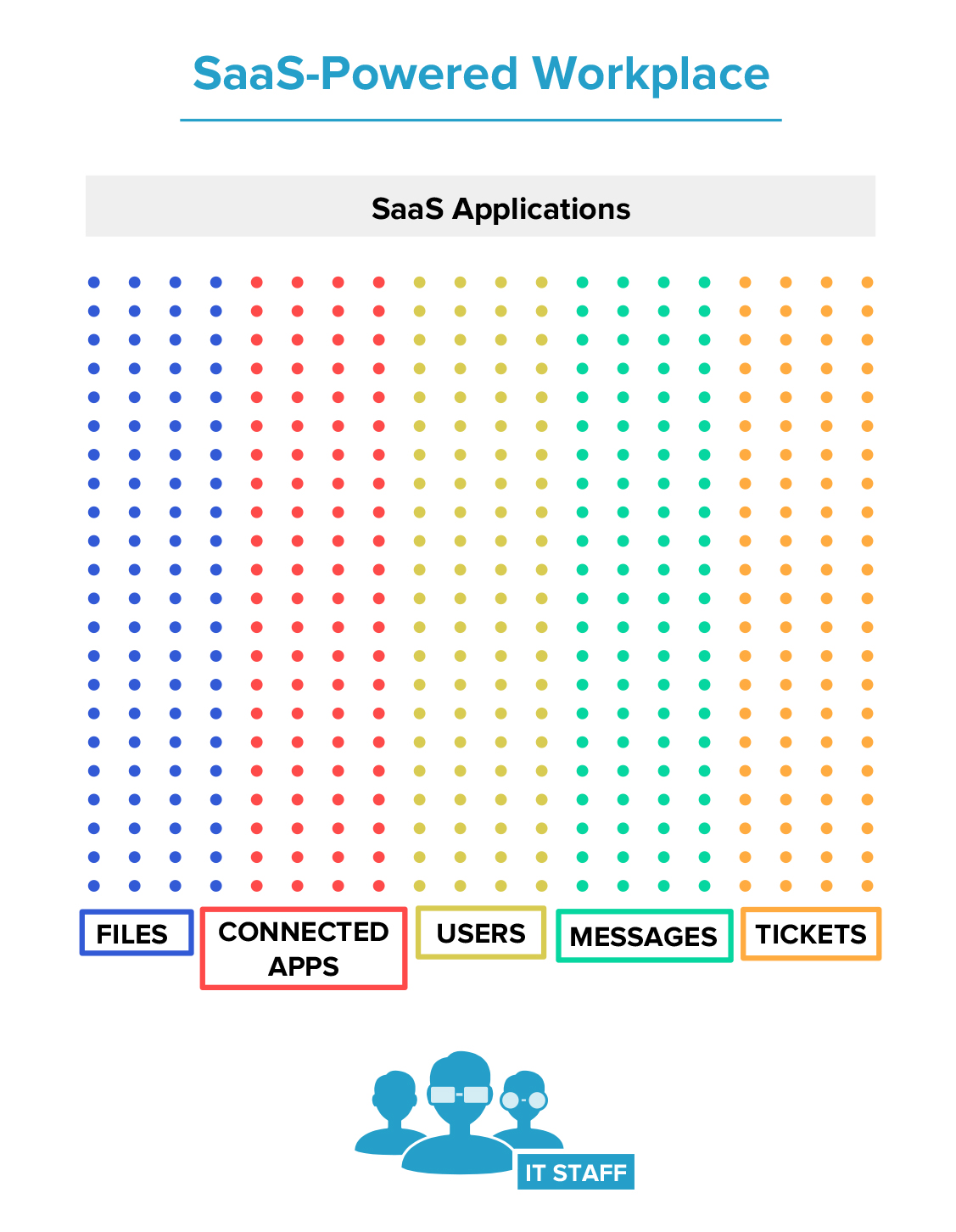Conquering SaaS Sprawl: Why Managing SaaS Apps Requires a Radical Shift in Mindset
March 1, 2017
5 minute read

How many SaaS applications does your organization use today? 1? 10? 100?
Research shows that by mid-2017, large enterprises expect to have adopted 52 SaaS applications on average.
If you’re not quite there yet, you will be–eventually. Sixty-two percent of all organizations surveyed in our Trends in Cloud IT Survey say they will run 100% of their IT in the cloud by 2022.
But as SaaS adoption grows, so does the amount of data living in those SaaS applications, which in turn creates an enormous, decentralized information sprawl. Where SaaS data lives, who has access to it, where it’s exposed–it all becomes nebulous.
“Know your data: if you don’t know where your data resides, you can’t protect it,” writes CIO.
So what’s the solution to controlling this sprawl? This is the problem thousands of forward-thinking IT professionals are facing every day as their organizations adopt more and more SaaS applications. And most are trying to centralize SaaS applications and their data in one way or another. But this is no easy task.
Let’s take a quick step back in time to understand how we got here.
A Long Time Ago in a Galaxy Far, Far Away…
Long before SaaS became a household acronym, before “as-a-service” became de rigueur, before we met its other -aaS cousins like PaaS and IaaS, there were on-premise environments.
Years ago, in traditional legacy infrastructures, IT professionals racked and stacked servers in data centers. Everything lived under one roof; data centralization wasn’t a problem. Files and emails were stored locally on computers, and IT knew, often with absolute certainty, where data lived.
Then companies took their first steps into the cloud. But even when they adopted cloud office suites like G Suite and Office 365, data sprawl still wasn’t a problem. In these cloud office environments, IT knew their data fell neatly under Google or Microsoft.

Organizations could adopt every workload within G Suite or Office 365, and rest assured that all of that data lived in one place, safely (although often not efficiently) managed in one admin console.
That Was Then, This is Now
In the age of the SaaS-Powered Workplace, organizations’ needs are fulfilled by a wide variety of best-in-breed cloud applications from many vendors. Over 1,400 new SaaS applications have launched in the last five years, and research shows that 86% of users say SaaS applications help them succeed more than desktop alternatives. In fact, 74% of users’ time is spent working directly in SaaS applications.
But as companies grow and adopt more SaaS applications, a new set of challenges arises. Yes, SaaS applications are a major boon to productivity and collaboration–you can work from anywhere, anytime, on any device–and they’re easily interoperable from an end user perspective. But they’re also creating a massive information sprawl, the likes of which IT has never seen before.
If you visualized data in an environment with multiple SaaS applications, it would probably look something like this:

Now imagine more dots being created every day–even every minute–for data types like messages and files. How could an IT team be expected to control, operate, and manage such an environment?
SaaS Data Sprawl = Digital Kudzu
As your organization grows, the amount of SaaS application data will also multiply by leaps and bounds. SaaS data is like the digital version of kudzu–its growth is rampant, it’s notoriously hard to control, and it can have harmful consequences if left unchecked. Furthermore, SaaS data is also fragmented; it lives in more places than you can shake a stick at. How many different admin consoles must you check every day to find the data you’re looking for?
Consider the many facets of information sprawl that IT must grapple with as SaaS adoption increases:
- The sheer amount of data. Your organization likely has tens of thousands–perhaps millions–of files. How do you ensure every single file is shared correctly and no sensitive data is inadvertently exposed to the public? One inappropriately shared document could have disastrous consequences, like a data breach or a HIPAA violation. The more data you have–the bigger that sprawl is–the more difficult it is to stay in compliance.
- The multiple places and devices where data lives. The “work from anywhere” SaaS mindset means that you have information living on not just one, but multiple devices: your company-issued laptop. Your Chromebook at home. Your mobile device. Plus, information lives in multiple places. You can share Drive and Dropbox files in Slack. You can install connected apps (like Chrome extensions, Slack bots, or marketplace apps) six ways to Sunday. Many SaaS apps work together in some way.
- The inability to accurately assign the right privileges to the right people. How do you view privileges in one place and assign them across the organization, across multiple applications, to make sure nobody has more privileges than they need? (Sidenote: We have a solution for this one.)
- The disparity across SaaS applications. Their settings are adjusted in different places (e.g., The G Suite Admin console vs. The Slack Team Settings page). They all have different nomenclatures (e.g., a G Suite “group” vs. a Slack “channel”). Each application has its own ecosystem–its own way of doing things, its own silo. There is no single unified view across SaaS applications for IT administrators.
Achieving Control Is Impossible
And that leads me to my most sobering point: This kind of wildfire-ish information sprawl means IT has little to no control over what enters the environment. Without the ability to centralize and view their organization’s data, IT lacks effective oversight. It impairs their capacity to understand what’s even happening in the environment. It undermines their control. All it takes is one user breezily hitting “Accept” on a malicious Chrome extension to wreak serious havoc in an organization. In fact, “with the right permissions, your new Chrome add-on could steal your user credentials, post as you on social media, read your emails, help launch a DDoS attack, and more,” writes BetaNews.
The control you have over your environment is tenuous at best. If you don’t have these problems now, you eventually will. So how do you get your arms around that kind of sprawl by yourself?
“This Weapon Is Your Life”

To truly rein in SaaS sprawl, you need to see your SaaS data in a single, centralized view. But the problem with SaaS data is that it’s all different: Files stored in Google Drive differ from those in Slack which differ from those in Salesforce. They’re stored in different places, and each application has its own set of APIs for accessing that data programmatically.
Solving this problem requires a new solution: “normalizing” SaaS application data so you can view it consistently in one place. You need to centralize and normalize data across all types, from users to files to messages to even IT-specific data objects, like tickets. While you are still faced with a mountain of SaaS application data, with normalization it starts to look less like kudzu and more like the neat, tidy vineyards of Napa Valley.
This is what we’ve built in BetterCloud’s new multi-SaaS management platform, where you can view and manage a single representation of a user and all of their applications, as well as the files created, stored, and shared across all of your applications, and much, much more.
It’s time to think critically about what SaaS sprawl means for your environment. What will you do to rein in the sprawl?
We’ve spent the last two years building the first-ever true multi-SaaS management platform, which centralizes and automates the administration of SaaS applications, launching it in December of 2016. Expect more exciting announcements and functionality like this one throughout 2017 as we add on to the platform. To learn more, request a personalized consultation with our team.






